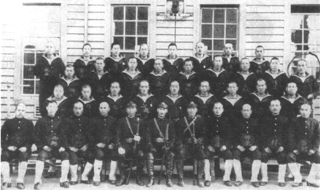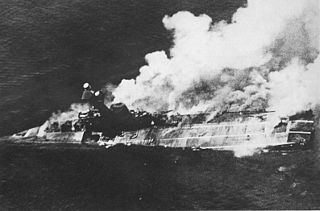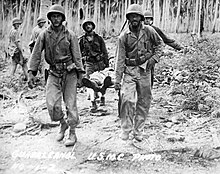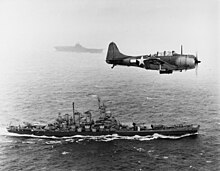
Chester William Nimitz was a fleet admiral in the United States Navy. He played a major role in the naval history of World War II as Commander in Chief, US Pacific Fleet, and Commander in Chief, Pacific Ocean Areas, commanding Allied air, land, and sea forces during World War II.

The Asiatic-Pacific Theater was the theater of operations of U.S. forces during World War II in the Pacific War during 1941–1945. From mid-1942 until the end of the war in 1945, two U.S. operational commands were in the Pacific. The Pacific Ocean Areas (POA), divided into the Central Pacific Area, the North Pacific Area and the South Pacific Area, were commanded by Fleet Admiral Chester W. Nimitz, Commander-in-Chief Pacific Ocean Areas. The South West Pacific Area (SWPA) was commanded by General of the Army Douglas MacArthur, Supreme Allied Commander South West Pacific Area. During 1945, the United States added the United States Strategic Air Forces in the Pacific, commanded by General Carl A. Spaatz.

The Mariana and Palau Islands campaign, also known as Operation Forager, was an offensive launched by United States forces against Imperial Japanese forces in the Mariana Islands and Palau in the Pacific Ocean between June and November 1944 during the Pacific War. The United States offensive, under the overall command of Chester W. Nimitz, followed the Gilbert and Marshall Islands campaign and was intended to neutralize Japanese bases in the central Pacific, support the Allied drive to retake the Philippines, and provide bases for a strategic bombing campaign against Japan.

Raymond Ames Spruance was a United States Navy admiral during World War II. He commanded U.S. naval forces during the Battle of the Philippine Sea, one of the most significant naval battles of the Pacific Theatre. He also commanded Task Force 16 at the Battle of Midway, comprising the carriers Enterprise and Hornet. At Midway, dive bombers from Enterprise sank four larger carriers of the Imperial Japanese Navy. Most historians consider Midway the turning point of the Pacific War.
During World War II, the United States Army divided its operations around the world into four theaters. Forces from many different Allied nations fought in these theaters. Other Allied countries have different conceptions of the theaters and/or different names for them.
Supreme Allied Commander is the title held by the most senior commander within certain multinational military alliances. It originated as a term used by the Allies during World War I, and is currently used only within NATO for Supreme Allied Commander Europe and Supreme Allied Commander Transformation.

The Fast Carrier Task Force was the main striking force of the United States Navy in the Pacific War from January 1944 through the end of the war in August 1945. The task force was made up of several separate task groups, each typically built around three to four aircraft carriers and their supporting vessels. The support vessels were screening destroyers, cruisers, and the newly built fast battleships.

The Asiatic–Pacific Campaign Medal is a United States military award of the Second World War, which was awarded to any member of the United States Armed Forces who served in the Asiatic-Pacific Theater from 1941 to 1945. The medal was created on November 6, 1942, by Executive Order 9265 issued by President Franklin D. Roosevelt. The medal was designed by Thomas Hudson Jones; the reverse side was designed by Adolph Alexander Weinman which is the same design as used on the reverse of the American Campaign Medal and European-African-Middle Eastern Campaign Medal.

The South-East Asian Theatre of World War II consisted of the campaigns of the Pacific War in the Philippines, Thailand, Indonesia, Indochina, Burma, India, Malaya and Singapore between 1941 and 1945.

Vice Admiral Robert Lee Ghormley was an admiral in the United States Navy who served as Commander, South Pacific Area during World War II. Ghormley was long considered to be an ineffective leader–overly cautious, pessimistic, and even defeatist–but recent scholarship has shown that while he may not have been an inspiring leader, he performed well under difficult circumstances.

Pacific Ocean Areas was a major Allied military command in the Pacific Ocean theater of World War II. It was one of four major Allied commands during the Pacific War and one of three United States commands in the Asiatic-Pacific Theater. Admiral Chester W. Nimitz of the U.S. Navy, Commander in Chief, U.S. Pacific Fleet, headed the command throughout its existence.

The New Guinea campaign of the Pacific War lasted from January 1942 until the end of the war in August 1945. During the initial phase in early 1942, the Empire of Japan invaded the Territory of New Guinea on 23 January and Territory of Papua on 21 July and overran western New Guinea beginning on 29 March. During the second phase, lasting from late 1942 until the Japanese surrender, the Allies—consisting primarily of Australian forces—cleared the Japanese first from Papua, then New Guinea, and finally from the Dutch colony.

The invasion of Tulagi, on 3–4 May 1942, was part of Operation Mo, the Empire of Japan's strategy in the South Pacific and South West Pacific Area in 1942. The plan called for Imperial Japanese Navy troops to capture Tulagi and nearby islands in the British Solomon Islands Protectorate. The occupation of Tulagi by the Japanese was intended to cover the flank of and provide reconnaissance support for Japanese forces that were advancing on Port Moresby in New Guinea, provide greater defensive depth for the major Japanese base at Rabaul, and serve as a base for Japanese forces to threaten and interdict the supply and communication routes between the United States and Australia and New Zealand.

The South West Pacific theatre, during World War II, was a major theatre of the war between the Allies and the Axis. It included the Philippines, the Dutch East Indies, Borneo, Australia and its mandate Territory of New Guinea and the western part of the Solomon Islands. This area was defined by the Allied powers' South West Pacific Area (SWPA) command.
Sea Frontiers were several, now disestablished, commands of the United States Navy as areas of defense against enemy vessels, especially submarines, along the U.S. coasts. They existed from 1 July 1941 until in some cases the 1970s. Sea Frontiers generally started at the shore of the United States and extended outwards into the sea for a nominal distance of two hundred miles.

Ralph Andrew Ofstie was a Vice Admiral in the United States Navy, an escort carrier commander in World War II, Deputy Chief of Naval Operations (Air), and Commander of the U.S. Sixth Fleet. He was born in Eau Claire, Wisconsin and his hometown was Everett, Washington.

Prior to World War II, the Indian Ocean was an important maritime trade route between European nations and their colonial territories in East Africa, the Arabian Peninsula, British India, Indochina, the East Indies (Indonesia), and Australia for a long time. Naval presence was dominated by the Royal Navy Eastern Fleet and the Royal Australian Navy as World War II began, with a major portion of the Royal Netherlands Navy operating in the Dutch East Indies and the Red Sea Flotilla of the Italian Regia Marina operating from Massawa.
At the beginning of World War II, the Royal Navy was the strongest navy in the world, with the largest number of warships built and with naval bases across the globe. It had over 15 battleships and battlecruisers, 7 aircraft carriers, 66 cruisers, 164 destroyers and 66 submarines. With a massive merchant navy, about a third of the world total, it also dominated shipping. The Royal Navy fought in every theatre from the Atlantic, Mediterranean, freezing Northern routes to Russia and the Pacific ocean.
This is a Bibliography of World War II battles and campaigns in East Asia, South East Asia, India and the Pacific. It aims to include the major theaters, campaigns and battles of the Asia-Pacific Theater of World War II. It is part of Wikipedia's larger effort to document the Bibliography of World War II. Its counterpart for the European, North African and Middle Eastern theater is the Bibliography of World War II battles and campaigns in Europe, North Africa and the Middle East.

















